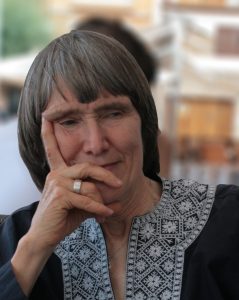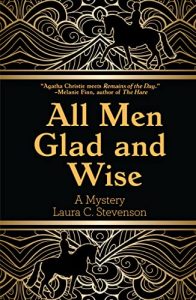Writing All Men Glad and Wise
Laura C. Stevenson
“Novel writing can be a cold-blooded business. One uses whatever happens to be lying around in memory and employs it to suit one’s needs.” J. L. Carr, Foreword to A Month in the Country.
 The things lying around in my memory when I first considered writing a mystery formed an unlikely mix. The most distant memory was one of childhood summers spent riding horses in the morning and reading Agatha Christie’s country house mysteries in the afternoon. More recent memories included writing about Victorian/Edwardian history and culture, writing non-mystery novels, running a small stable, and enjoying the wonderful effects of dressage training on the only horses a teacher in rural Vermont could afford to own.
The things lying around in my memory when I first considered writing a mystery formed an unlikely mix. The most distant memory was one of childhood summers spent riding horses in the morning and reading Agatha Christie’s country house mysteries in the afternoon. More recent memories included writing about Victorian/Edwardian history and culture, writing non-mystery novels, running a small stable, and enjoying the wonderful effects of dressage training on the only horses a teacher in rural Vermont could afford to own.
A specific memorable event occurred when I visited England to do research on late Victorian children’s literature: my brother-in-law took me to Wallington Hall, the Northumberland estate of the family of G.M. Trevelyan, a historian I greatly admired. The historian was a younger brother; the eldest brother was Sir Charles Trevelyan—a baronet who was also a committed socialist. The handsome house, the stable that faced it in the courtyard, and the socialism all eventually worked their way into All Men Glad and Wise.
Twenty years passed after that event, however, before I began to do the research that would support a historical country house murder mystery narrated by a stable lad. My fictitious country house was based on half-forgotten impressions of Wallington Hall, “cold-bloodedly” moved from Northumberland to the Cotswolds and the Thames Pathway, with which I had personal experience. My half-forgotten impressions were refreshed by Giles Worsley’s splendid book The British Stable, which helped me recreate the architectural beauty of aristocrats’ stables. I also stumbled upon The Guide to Service: The Groom, a mid-nineteenth century manual written by an anonymous head groom with an inimitable voice. The book provided a splendid portrait of the endless work and the unspoken hierarchical rules that governed grooms’ lives. These works and hundreds of others, including Ishiguro’s The Remains of the Day, allowed me to develop the ‘feel’ of a landed estate in midlands England.
The idea of a girl brought up as a boy had been on my mind for some time, and giving her duties as a trainer and exercise boy allowed her freedom of movement that didn’t need explaining. Setting the story five months after the end of WWI enabled me to portray the effects of loss on estates and country villages. It also allowed me to consider the effects of the cataclysmic change in land ownership that was occurring at that time.
As David Cannadine has shown in his The Decline and Fall of the British Aristocracy, in 1870, the estates of the aristocracy and gentry covered 66% of all British land; in 1930, the much-reduced estates covered only 15%. The country houses that Agatha Christie used to define her species of murder mystery in 1920-1950 were, for the most part, pale shadows of those familiar to her parents’ generation. I hoped that presenting a baronet’s estate faced with bankruptcy would allow me to present the personal effects of social changes that affected thousands of real servants, tenants, and farmers in a single generation. Among those effects, of course, was the disappearance of grooms, as automobiles replaced horses as a means of transportation.
Once I had embedded myself in the period immediately following the Great War, there was simply the matter of plotting the mystery. I didn’t outline, because I’ve learned to accept my inability to do so (though I look with admiring envy at Dickens’s plot sketch of Bleak House, placing its 80 interlocking characters right where he needed them amidst the coming 800 pages). I started in with Harry’s finding the murder victim, then continued from there, introducing most of the characters in the first forty pages—at which point, the novel crashed and burned, and I had to sit down and figure out the back story before I could continue. Hardened to such events, I opened a file in which I belatedly constructed the history of each character, ready to be worked into the plot when necessary. I also outlined the novel I’d already written, tidied it up, and (finally) continued. After a few more pages, I began to head each chapter with the date and time its events occurred, to keep me on track.
When I finished the first draft, I was satisfied with Harry’s vulnerability and intelligence, but I found my inattention to the sub-plot had left me with an unsatisfactory ending. After letting the novel ferment in a drawer for a while, I went back to it, working in two new (and very important) characters that left me satisfied with the whole.
It was, as always, a long process, but also as always, one that I enjoy. The frustrations involved in rewriting—not just every chapter, but every page, every paragraph, every sentence—are many, but over the years, I’ve learned to believe in my ability to create order out of the words that tumble onto the page. That’s the one lesson I’ve passed on to the many beginning writers I’ve worked with: accept the many errors that come between you and the work that floats non-verbally in your head; then believe (Believe! Believe!) that patient revision will allow you to turn your ideas into words.
—
ALL MEN GLAD AND WISE
Category: How To and Tips

 The steward of Willingford Hall was murdered in the Dell on 12 March 1919. I found his body because I’d been thrown by a horse. It’s difficult to say which event was more unlikely.
The steward of Willingford Hall was murdered in the Dell on 12 March 1919. I found his body because I’d been thrown by a horse. It’s difficult to say which event was more unlikely.























